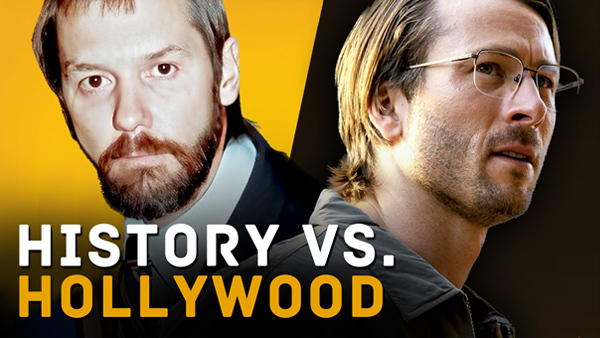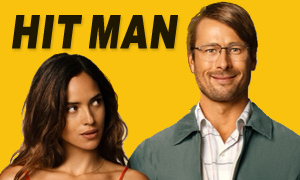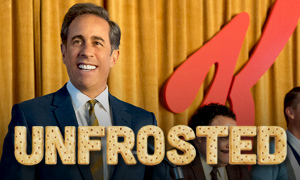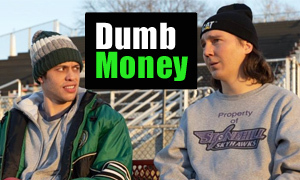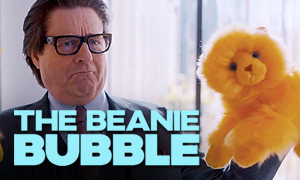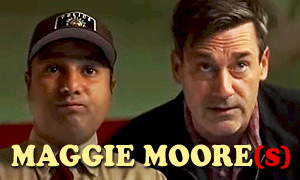The Beanie Bubble: History vs. Hollywood
Zach Galifianakis
Born: October 1, 1969
Birthplace:
Wilkesboro, North Carolina, USA
Ty Warner
Born: September 3, 1944
Birthplace: Chicago, Illinois, USA
How much of The Beanie Bubble is based on the true story?
In researching The Beanie Bubble true story, we discovered that broadly speaking, Apple TV+'s Beanie Baby movie is significantly fictionalized in terms of both its story and characters. It even warns us after the opening credits by flashing up the statement, "There are parts of the truth you can't make up. The rest we did." This type of statement is becoming all too common in movies that claim to be fact-based but at the same time want to avoid being scrutinized for adding too much fiction. While the movie is technically based on Zac Bissonnette's book, The Great Beanie Baby Bubble: Mass Delusion and the Dark Side of Cute, the filmmakers acknowledged that their story takes considerable liberties for comedic and dramatic effect.
"I think he's standing in for the American dream," said co-director Damian Kulash of Zach Galifianakis' character, Beanie Baby inventor Ty Warner. "We should be clear that we didn't research Ty, and these are not the actual women. This is a composite story that we learned from that book, and we're careful to say in the beginning, we made up a bunch of this, but that's mostly because we don't particularly care about these stuffed animals. We don't particularly care that the first consumer website was created by a 19-year-old, [a college student named Lina Trivedi]. That's an amazing factoid, but most of these things, it's the idea that what looks so absurd on the outside, like a mistake none of us could make, is the mistake we're all making at the same time." -MovieWeb
Did a truck full of Beanie Babies crash and spill its contents all over the highway in real life?
In the title sequence of the movie, a truck carrying boxes of Beanie Babies overturns on the highway at the height of the stuffed toy's popularity, spilling them all over the asphalt in an explosion of colors. Drivers hurry from their cars in a frenzy and mob the spill, scooping up the potentially valuable "casualties." Our Beanie Bubble fact-check confirms that this is based on a real-life accident. "It's a real incident that happened," co-director Kristin Gore told MovieWeb, "and it felt like a perfect metaphor for the entire movie, for everything we're trying to say with it." It's true that people hung out of or ran from their cars to scoop up the small plush toys. Helicopter footage captured the frenzy that ensued after the Beanie Babies truck crashed.
The Beanie Baby truck crash wasn't the only strange story surrounding the stuffed toy. In 1997, McDonald's was offering Teenie Beanie Babies in their Happy Meals. It was reported that at one McDonald's, someone ordered 100 Happy Meals and told the cashier to hold the food and just include the Teenie Beanie Babies. -Chicago Sun-Times
Does Zach Galifianakis' character, Ty Warner, resemble the real-life Beanie Baby mogul?
While researching The Beanie Bubble's historical accuracy, we learned that most of the characters in the film are either fictional or heavily fictionalized. This even includes Zach Galifianakis' character, Ty Warner, who is the founder of the toy company Ty Inc. and the inventor of Beanie Babies. Dubbed "the Steve Jobs of plush," Warner came up with the innovative concept of understuffing his plush toys so that they were poseable and flopped around in your hand while you held them. While Warner's name hasn't been changed for the film and many have described him as being similar to the narcissistic manipulator we see in the movie, Zach Galifianakis admitted that he is depicting a fictionalized version of the Beanie Babies creator.
"It's a fictionalized version of this man, it's important that I say that because I would never say, 'I studied him, and this is how he talked and walked and all that.' I didn't have those tools," Galifianakis told Marie Claire. The actor is alluding to the fact that due to his reclusive nature, little is known about the real Ty Warner, other than what you can read on his Wikipedia page. Galifianakis said he was unable to find any interviews or footage of Warner. This is somewhat similar to Matt Johnson's heavily fictionalized portrayal of Doug Fregin in Blackberry, one of this year's other movies to chronicle the origin story of a '90s product that became wildly popular.
Are Ty Warner's girlfriends in the movie (played by Elizabeth Banks and Sarah Snook) based on real people?
In the Beanie Bubble movie, Ty Warner (Zach Galifianakis) has two successive girlfriends, Robbie Jones (Elizabeth Banks) and Sheila Harper (Sarah Snook), who partially overlap. Robbie was inspired by Ty Warner's former real-life girlfriend Patricia Roche, who helped found Ty Inc. and made a fortune operating the company's UK distribution. However, Elizabeth Banks explained that while Patricia was the inspiration for her character, she was more of a jumping-off point than a blueprint for Banks to copy. "There were a lot of touch points, but I also, as an actor, felt really freed by this notion that we were dramatizing so much of it and that Patti was an inspiration and a jumping-off point but Robbie, I had to create a real character out of what Kristin Gore's script offered me." -Marie Claire
It's true that Patricia Roche left the company after their breakup when Warner tracked her and a potential new boyfriend down in Cancun and unsuccessfully tried to win her back. Warner reached out to her three years later to try and convince her to come back and run Ty UK. In real life, Roche had barely been getting by selling insurance. In the movie, Elizabeth Banks' character tells him that she will never work for him again, and reveals that she's starting her own company that will be the exclusive wholesaler of Ty products in the UK. However, in reality, she did work for him again. She did not start her own company but rather accepted his offer to run Ty UK. She headed to England to handle Ty's distribution there. As the book notes, the Ty UK distributorship made her "richer than she ever could have imagined becoming." In fact, she became one of the highest-paid female executives in England.
The Beanie Bubble true story reveals that Sarah Snook's character, Sheila Harper, was inspired by Ty Warner's longtime girlfriend Faith McGowan, who was involved in the operations of his company, Ty Inc., during the rise of the Beanie Babies craze. It's true that McGowan ended up moving into Warner's Oak Brook house with her two elementary-age daughters. The children saw him as a father figure (Chicago Magazine).
Is Geraldine Viswanathan's character, Maya Kumar, based on an actual person?
In researching the question, "Is The Beanie Bubble accurate?" we learned that Geraldine Viswanathan's character, Maya Kumar, is based on Ty Inc. designer Lina Trivedi, a student at DePaul University. Not only did Trivedi come up with the idea of including a unique birthday and poem on each Beanie Baby tag (she wrote the first 136 poems), she also designed and managed the Beanie Baby website (Ty.com) so that the company could sell directly to consumers. Trivedi is noted as having created the "first Business to Consumer website that presented the world with the first Internet sensation." In his book The Great Beanie Baby Bubble, author Zac Bissonnette describes Lina Trivedi as "the $12-per-hour sociology major who made Ty Warner a billionaire."
Though she was clearly inspired by Trivedi, Geraldine Viswanathan's character Maya is somewhat fictionalized as well. This explains the name change in the movie. For example, she did not come up with the idea of retiring certain Beanie Babies, which incited a global craze. It was actually the King brothers, distributors for Ty Inc. in several southern states, who came up with the idea of "retirements." -Chicago Sun-Times
Did the real Maya design the website with the help of her brother, who was still in high school?
Yes. It's true that Maya (Geraldine Viswanathan), whose actual name is Lina Trivedi, designed the Ty Inc. website with the help of her brother, Nikhil Trivedi, who was still in high school. Below is a screenshot of how the website looked shortly after it launched in 1996.
Did Sheila go to the hotel room where Ty was cheating on her with Robbie?
This was indeed inspired by a real-life event that happened on Christmas Eve 1998. By this time, Ty's ex Patricia Roche (the real-life Robbie) was running Ty UK and had returned to Chicago to visit her parents for the holiday. While in town, she was staying at an Embassy Suites Hotel not far from Ty's office. Faith McGowan (the real-life Sheila) had been planning a romantic evening for Ty when he got home from an afternoon meeting with a printer. She chilled a bottle of wine and prepared a filet, but Ty never came home.
Knowing Patricia was in town, Faith went to her hotel to look for Ty. She saw his black Mercedes in the parking lot. Unlike the movie, she did not go to Patricia's hotel room and confront her. She called her room from the front desk and when Patricia answered, she asked to speak to Ty. "I know he's there," she said. Patricia replied, "Leave us alone! You have the house. You have the car. You have him. What more do you want?" Faith demanded to speak to Ty. He got on the phone and tried to lie and say he had just stopped by the hotel to show Patricia the new catalog.
Patricia advised Ty to go out the side entrance and not make a scene at a hotel so close to the office. Ty didn't listen to her and went to the lobby. Similar to what's seen in The Beanie Bubble movie, when the elevator door opened, Faith punched Ty in the face. The hotel manager had predicted there might be a physical altercation and had already summoned the police. They grabbed Faith and wanted to file a report, but Ty dissuaded them and he and Faith went home. Contrary to the movie's depiction, Faith forgave him for his infidelity.
Their relationship did eventually come to an end. However, Faith did not secure her future without Ty by selling her daughter's Spooky the Ghost Beanie Babies just before the bubble burst. In real life, Ty finally relented and gave her about $6 million, mostly in the form of a Santa Barbara mansion he signed over to her. -The Great Beanie Baby Bubble
Why were Beanie Babies so popular?
Ty Inc. employee Lina Trivedi's idea of personalizing each toy by attributing to it a birthday and a poem helped them grow in popularity. Their low price tag of $5 was appealing to adult collectors, who turned around and sold Beanie Babies at higher prices on eBay. This worked especially well since the demand often outpaced the supply (sometimes intentionally), making them more desirable the rarer they seemed to consumers and retailers. Ty Inc., the company that produced the stuffed toy, also realized that if they did limited runs of certain Beanie Babies, and retired others, it would create a buying frenzy. These strategies were highly effective, but as with the Cabbage Patch Kids craze in the 1980s, the fad eventually started to wear off, and by the end of the 1990s, the Beanie Baby bubble burst and sales started to slip.
How much did Beanie Babies resell for at the height of the craze?
A Beanie Bubble fact-check reveals that while they sold for only $5 on store shelves, their resale values on eBay were often much higher. For example, a mint condition Patti the Platypus once sold for $6,000. A Brownie the Bear in perfect condition raked in a whopping $20,000. What was the most expensive Beanie Baby? Princess Bear, created as a tribute to Princess Diana after her untimely passing, once sold for $500,000.
Beanie Babies and the e-commerce site eBay were a match made in Heaven. The plush toys accounted for 10% of all sales on eBay in 1998. The average listed resale price was $30, six times the original ticket price. -Chicago Sun-Times
Did Ty Warner give his 250+ employees cash bonuses equal to their entire 1998 income?
Yes. This comes straight from what is reported in Zac Bissonnette's book. At the company Christmas party on December 12, 1998, Warner announced that all of Ty's employees would be receiving cash bonuses equal to their entire 1998 income. A month later, the Wall Street Journal reported on his act of generosity, casting him in a positive light. Ty's general manager at the time, Sharon Altier, says that "he did it for ego." At the same Christmas party, he also gave the employees a special red Beanie Baby called #1 Bear, which had the number 1 stitched on its chest. The tag let them know that only 253 #1 Bears had been produced, making them extremely valuable to collectors. A few weeks later, they were being resold online for $5,000 or more.
Is the real Maya bitter over her experience working for Ty Warner?
No. In real life, Maya's name is Lina Trivedi. After watching The Beanie Bubble, Trivedi took to Instagram to share her thoughts on the movie. "Reporters ask me if I am bitter, and my response has always been no," says Trivedi. "I am beyond grateful for having this insane experience that has shaped my professional skill sets and my life. And I still love #BeanieBabies and I still have an emotional connection to the ones that I helped shape."
Trivedi said it's odd seeing the movie depict so many facts from her story "but from a different point of view." The movie depicts her as being used by Ty Warner, who never compensates her for her significant contributions. She grows bitter and quits in disgust, but at the same time feels liberated for doing so. However, the real Trivedi doesn't seem to agree with the movie's fictionalized perspective.
Did Ty Warner buy hotels with his profits from selling Beanie Babies?
Yes. Unlike many of the collectors who hoped to get rich off their Beanie Babies, Ty Warner wasn't affected too badly when the Beanie Bubble burst around the turn of the millennium. He had amassed enough wealth from his company's success that he had become one of the richest people alive. He broadened his focus into investing in hotels. Warner bought the Four Seasons Hotel in New York City. He also purchased a number of other hotels and resorts over the years, including Santa Barbara's Sandpiper Golf Club; the San Ysidro Ranch in Montecito, California; the Four Seasons Resort The Biltmore Santa Barbara; the Kona Village resort on Hawaii's Big Island; the Montecito Country Club; and Mexico's Las Ventanas al Paraiso Resort in Los Cabos.
Was Ty Warner convicted of tax fraud?
Yes. The Beanie Bubble true story confirms that Warner was sentenced to two years of probation and hit with a $53 million fine for concealing over $100 million of his income in an offshore bank account. However, the fine only amounted to two percent of his net worth. Arguably, his reputation was damaged more than his fortune. -Mental Floss
Did Al Gore's daughter direct The Beanie Bubble?
Yes. While exploring The Beanie Bubble fact vs. fiction, we discovered that author and screenwriter Kristin Gore, the daughter of former Vice President Al Gore, wrote and co-directed the Apple TV+ Beanie Babies movie. Her co-director was her husband, OK Go frontman Damian Kulash. Kristin is the author of three novels, as well as a former writer for the animated series Futurama and the long-running sketch comedy TV show Saturday Night Live.
Kristin's father, Al Gore, is also known for his climate crisis book An Inconvenient Truth and the corresponding documentary of the same name.
Overall, how accurate is The Beanie Bubble?
In telling their Beanie Babies story, the filmmakers opted not to heavily focus on the rags-to-riches tale of a man who gets ridiculously wealthy off selling small poseable stuffed toys, or how this seemingly insignificant product became a cultural phenomenon. While those two elements are present, the focus of The Beanie Bubble is instead largely on the mostly unheard-of women in Ty Warner's life, who the film emphasizes were vital to the toy's success. However, writer and co-director Kristin Gore said that in order for the women "to feel universal," they created characters that were sometimes composites rather than directly based on real people. This is one reason why the three women's names in the movie are made up. They used three real-life women as jumping-off points to create fictionalized characters. -Marie Claire
This Beanie Babies movie is by no means a love letter to the little stuffed toys that might currently be jammed into a plastic bin in the corner of your attic. Instead, the filmmakers use the Beanie Babies craze and the story of toy mogul Ty Warner and the women around him as a starting point to create a fictionalized commentary that expresses their own views on capitalism, gender inequality, and the patriarchy. At the end of the film, Ty Warner (Zach Galifianakis) is extremely wealthy and successful, but he's unhappy and alone in his tower. The women who helped him achieve his American dream have all abandoned him, apparently realizing that they were being used in a system that was rigged toward Warner, a man, and that the "dream" they were chasing wasn't all it was cracked up to be. The movie suggests they're better off for having jumped ship.
"We've talked a lot about how there's this myth of a lone male genius coming up with things. You see it over and over again, benefiting from a system that's rigged for him and against everyone else," co-director Kristin Gore told MovieWeb. "And we wanted to peel back those layers and look at that myth and really show what everyone knows, which is that there's always so much more to that story. There are always so many more people involved."
To some degree, it can be argued that Gore hijacked the story of Ty Warner and fictionalized the characters where necessary to drive her commentary on capitalism home. In any case, the movie works best where it sticks to the facts.
